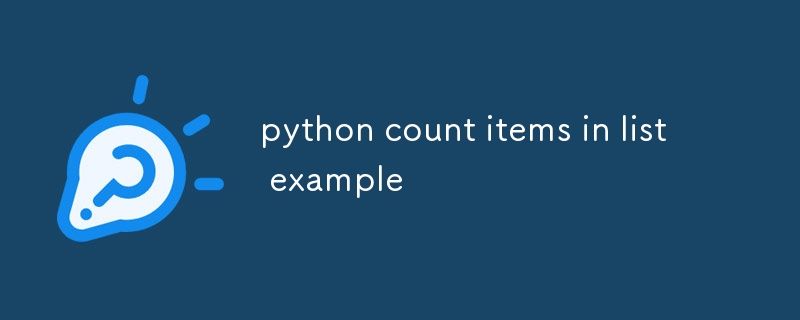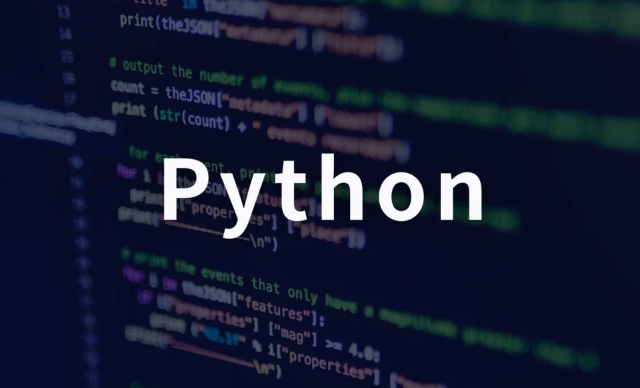python count items in list example
Use len() to count the total number of elements in the list, such as len([1, 2, 3, 4, 5]) to return 5; 2. Use count() to count the number of occurrences of a specific element, such as ['apple', 'banana', 'apple'].count('apple') to return 3; 3. Use collections.Counter to count the frequency of each element, such as Counter(['a', 'b', 'a']) to output Counter({'a': 3, 'b': 2, 'c': 1}); 4. Use dictionary to manually count the traversal and get methods to achieve the same effect, such as loop accumulation to obtain {'a': 3, 'b': 2, 'c': 1}.

There are many ways to count the number of elements in a list in Python. Here are some common examples and usage scenarios.

1. Use len() to count the total length of the list
If you want to count the total number of elements in the list (regardless of duplication or not):
my_list = [1, 2, 3, 4, 5] count = len(my_list) print(count) # Output: 5
2. Use count() to count the number of occurrences of a specific element
If you want to count how many times an element appears in the list:

my_list = ['apple', 'banana', 'apple', 'cherry', 'apple'] count_apple = my_list.count('apple') print(count_apple) # Output: 3
Note: count() is case sensitive and only counts exactly matched items.
['Apple', 'apple'].count('apple') # Output: 1
3. Statistics the number of occurrences of all elements (using collections.Counter )
If you want to know how many times each element in the list appears, it is recommended to use Counter :

from collections import Counter
my_list = ['a', 'b', 'a', 'c', 'b', 'a']
counter = Counter(my_list)
print(counter) # Output: Counter({'a': 3, 'b': 2, 'c': 1})
# Get the count of an element print(counter['a']) # Output: 3
# Get the most common element print(counter.most_common(1)) # Output: [('a', 3)]4. Use dictionary to manually count (without Counter)
You can also use normal dictionaries to implement similar functions:
my_list = ['a', 'b', 'a', 'c', 'b', 'a']
count_dict = {}
for item in my_list:
count_dict[item] = count_dict.get(item, 0) 1
print(count_dict) # Output: {'a': 3, 'b': 2, 'c': 1}summary
- Total number: use
len(list) - The number of times a certain element is to be used: use
list.count(item) - To the frequency of all elements: use
collections.Counter(list)
Basically, these commonly used methods are not complicated but very practical.
The above is the detailed content of python count items in list example. For more information, please follow other related articles on the PHP Chinese website!

Hot AI Tools

Undress AI Tool
Undress images for free

Undresser.AI Undress
AI-powered app for creating realistic nude photos

AI Clothes Remover
Online AI tool for removing clothes from photos.

Clothoff.io
AI clothes remover

Video Face Swap
Swap faces in any video effortlessly with our completely free AI face swap tool!

Hot Article

Hot Tools

Notepad++7.3.1
Easy-to-use and free code editor

SublimeText3 Chinese version
Chinese version, very easy to use

Zend Studio 13.0.1
Powerful PHP integrated development environment

Dreamweaver CS6
Visual web development tools

SublimeText3 Mac version
God-level code editing software (SublimeText3)

Hot Topics
 1794
1794
 16
16
 1740
1740
 56
56
 1591
1591
 29
29
 1474
1474
 72
72
 267
267
 587
587
 python check if key exists in dictionary example
Jul 27, 2025 am 03:08 AM
python check if key exists in dictionary example
Jul 27, 2025 am 03:08 AM
It is recommended to use the in keyword to check whether a key exists in the dictionary, because it is concise, efficient and highly readable; 2. It is not recommended to use the get() method to determine whether the key exists, because it will be misjudged when the key exists but the value is None; 3. You can use the keys() method, but it is redundant, because in defaults to check the key; 4. When you need to get a value and the expected key usually exists, you can use try-except to catch the KeyError exception. The most recommended method is to use the in keyword, which is both safe and efficient, and is not affected by the value of None, which is suitable for most scenarios.
 reading from stdin in go by example
Jul 27, 2025 am 04:15 AM
reading from stdin in go by example
Jul 27, 2025 am 04:15 AM
Use fmt.Scanf to read formatted input, suitable for simple structured data, but the string is cut off when encountering spaces; 2. It is recommended to use bufio.Scanner to read line by line, supports multi-line input, EOF detection and pipeline input, and can handle scanning errors; 3. Use io.ReadAll(os.Stdin) to read all inputs at once, suitable for processing large block data or file streams; 4. Real-time key response requires third-party libraries such as golang.org/x/term, and bufio is sufficient for conventional scenarios; practical suggestions: use fmt.Scan for interactive simple input, use bufio.Scanner for line input or pipeline, use io.ReadAll for large block data, and always handle
 SQL Serverless Computing Options
Jul 27, 2025 am 03:07 AM
SQL Serverless Computing Options
Jul 27, 2025 am 03:07 AM
SQLServer itself does not support serverless architecture, but the cloud platform provides a similar solution. 1. Azure's ServerlessSQL pool can directly query DataLake files and charge based on resource consumption; 2. AzureFunctions combined with CosmosDB or BlobStorage can realize lightweight SQL processing; 3. AWSathena supports standard SQL queries for S3 data, and charge based on scanned data; 4. GoogleBigQuery approaches the Serverless concept through FederatedQuery; 5. If you must use SQLServer function, you can choose AzureSQLDatabase's serverless service-free
 Optimizing Database Interactions in a Java Application
Jul 27, 2025 am 02:32 AM
Optimizing Database Interactions in a Java Application
Jul 27, 2025 am 02:32 AM
UseconnectionpoolingwithHikariCPtoreusedatabaseconnectionsandreduceoverhead.2.UsePreparedStatementtopreventSQLinjectionandimprovequeryperformance.3.Fetchonlyrequireddatabyselectingspecificcolumnsandapplyingfiltersandpagination.4.Usebatchoperationstor
 Java Cloud Integration Patterns with Spring Cloud
Jul 27, 2025 am 02:55 AM
Java Cloud Integration Patterns with Spring Cloud
Jul 27, 2025 am 02:55 AM
Mastering SpringCloud integration model is crucial to building modern distributed systems. 1. Service registration and discovery: Automatic service registration and discovery is realized through Eureka or SpringCloudKubernetes, and load balancing is carried out with Ribbon or LoadBalancer; 2. Configuration center: Use SpringCloudConfig to centrally manage multi-environment configurations, support dynamic loading and encryption processing; 3. API gateway: Use SpringCloudGateway to unify the entry, routing control and permission management, and support current limiting and logging; 4. Distributed link tracking: combine Sleuth and Zipkin to realize the full process of request visual pursuit.
 VSCode setup for Java development
Jul 27, 2025 am 02:28 AM
VSCode setup for Java development
Jul 27, 2025 am 02:28 AM
InstallJDK,setJAVA_HOME,installJavaExtensionPackinVSCode,createoropenaMaven/Gradleproject,ensureproperprojectstructure,andusebuilt-inrun/debugfeatures;1.InstallJDKandverifywithjava-versionandjavac-version,2.InstallMavenorGradleoptionally,3.SetJAVA_HO
 python binary search example
Jul 27, 2025 am 02:54 AM
python binary search example
Jul 27, 2025 am 02:54 AM
Binary searches must be performed in an ordered array, and the core is to efficiently locate the target value by continuously narrowing the search range. 1. The algorithm starts comparing from the intermediate elements of the array. If the target value is equal to the intermediate element, it returns the index; 2. If the target value is greater than the intermediate element, it continues to search in the right half interval; 3. If the target value is less than the intermediate element, it continues to search in the left half interval; 4. Repeat this process until the target value is found or the search interval is empty, and if it is not found, it returns -1. The time complexity is O(logn), the space complexity is O(1) (iteration version) or O(logn) (recursive version). Common errors include unsorted arrays, boundary update errors, and ignoring integer overflow problems. This algorithm requires that data is ordered and suitable for static or less variable datasets.
 Mastering Maven for Java Project Management
Jul 27, 2025 am 02:58 AM
Mastering Maven for Java Project Management
Jul 27, 2025 am 02:58 AM
MasterthePOMasadeclarativeblueprintdefiningprojectidentity,dependencies,andstructure.2.UseMaven’sbuilt-inlifecyclesandphaseslikecompile,test,andpackagetoensureconsistent,automatedbuilds.3.ManagedependencieseffectivelywithproperscopesanddependencyMana





